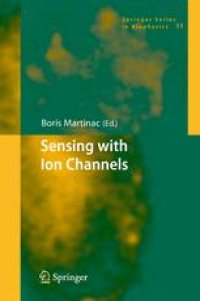
Ebook: Sensing with Ion Channels
Author: Ching Kung Xin-Liang Zhou Zhen-Wei Su W. John Haynes (auth.) Professor Boris Martinac (eds.)
- Tags: Biochemistry general, Biophysics and Biological Physics, Cell Biology, Bioorganic Chemistry
- Series: Springer Series in Biophysics 11
- Year: 2008
- Publisher: Springer-Verlag Berlin Heidelberg
- Edition: 1
- Language: English
- pdf
All living cells are able to detect and translate environmental stimuli into biologically meaningful signals. Sensations of touch, hearing, sight, taste, smell or pain are essential to the survival of all living organisms. The importance of sensory input for the existence of life thus justifies the effort made to understand its molecular origins. Sensing with Ion Channels focuses on ion channels as key molecules enabling biological systems to sense and process the physical and chemical stimuli that act upon cells in their living environment. Its aim is to serve as a reference to ion channel specialists and as a source of new information to non specialists who want to learn about the structural and functional diversity of ion channels and their role in sensory physiology.
All living cells are able to detect and translate environmental stimuli into biologically meaningful signals. Sensations of touch, hearing, sight, taste, smell or pain are essential to the survival of all living organisms. The importance of sensory input for the existence of life thus justifies the effort made to understand its molecular origins. Sensing with Ion Channels focuses on ion channels as key molecules enabling biological systems to sense and process the physical and chemical stimuli that act upon cells in their living environment. Its aim is to serve as a reference to ion channel specialists and as a source of new information to non specialists who want to learn about the structural and functional diversity of ion channels and their role in sensory physiology.
All living cells are able to detect and translate environmental stimuli into biologically meaningful signals. Sensations of touch, hearing, sight, taste, smell or pain are essential to the survival of all living organisms. The importance of sensory input for the existence of life thus justifies the effort made to understand its molecular origins. Sensing with Ion Channels focuses on ion channels as key molecules enabling biological systems to sense and process the physical and chemical stimuli that act upon cells in their living environment. Its aim is to serve as a reference to ion channel specialists and as a source of new information to non specialists who want to learn about the structural and functional diversity of ion channels and their role in sensory physiology.
Content:
Front Matter....Pages i-xxiii
Microbial Senses and Ion Channels....Pages 1-23
Mechanosensitive Channels and Sensing Osmotic Stimuli in Bacteria....Pages 25-45
Roles of Ion Channels in the Environmental Responses of Plants....Pages 47-67
Ion Channels, Cell Volume, Cell Proliferation and Apoptotic Cell Death....Pages 69-84
TRPV Ion Channels and Sensory Transduction of Osmotic and Mechanical Stimuli in Mammals....Pages 85-100
Mechanisms of Thermosensation in TRP Channels....Pages 101-120
TRPC Family of Ion Channels and Mechanotransduction....Pages 121-160
Mechano- and Chemo-Sensory Polycystins....Pages 161-174
Biophysics of CNG Ion Channels....Pages 175-200
Sensory Transduction in Caenorhabditis elegans....Pages 201-223
Epithelial Sodium and Acid-Sensing Ion Channels....Pages 225-246
P2X3 Receptors and Sensory Transduction....Pages 247-266
Voltage-Gated Calcium Channels in Nociception....Pages 267-298
Back Matter....Pages 299-304
All living cells are able to detect and translate environmental stimuli into biologically meaningful signals. Sensations of touch, hearing, sight, taste, smell or pain are essential to the survival of all living organisms. The importance of sensory input for the existence of life thus justifies the effort made to understand its molecular origins. Sensing with Ion Channels focuses on ion channels as key molecules enabling biological systems to sense and process the physical and chemical stimuli that act upon cells in their living environment. Its aim is to serve as a reference to ion channel specialists and as a source of new information to non specialists who want to learn about the structural and functional diversity of ion channels and their role in sensory physiology.
Content:
Front Matter....Pages i-xxiii
Microbial Senses and Ion Channels....Pages 1-23
Mechanosensitive Channels and Sensing Osmotic Stimuli in Bacteria....Pages 25-45
Roles of Ion Channels in the Environmental Responses of Plants....Pages 47-67
Ion Channels, Cell Volume, Cell Proliferation and Apoptotic Cell Death....Pages 69-84
TRPV Ion Channels and Sensory Transduction of Osmotic and Mechanical Stimuli in Mammals....Pages 85-100
Mechanisms of Thermosensation in TRP Channels....Pages 101-120
TRPC Family of Ion Channels and Mechanotransduction....Pages 121-160
Mechano- and Chemo-Sensory Polycystins....Pages 161-174
Biophysics of CNG Ion Channels....Pages 175-200
Sensory Transduction in Caenorhabditis elegans....Pages 201-223
Epithelial Sodium and Acid-Sensing Ion Channels....Pages 225-246
P2X3 Receptors and Sensory Transduction....Pages 247-266
Voltage-Gated Calcium Channels in Nociception....Pages 267-298
Back Matter....Pages 299-304
....